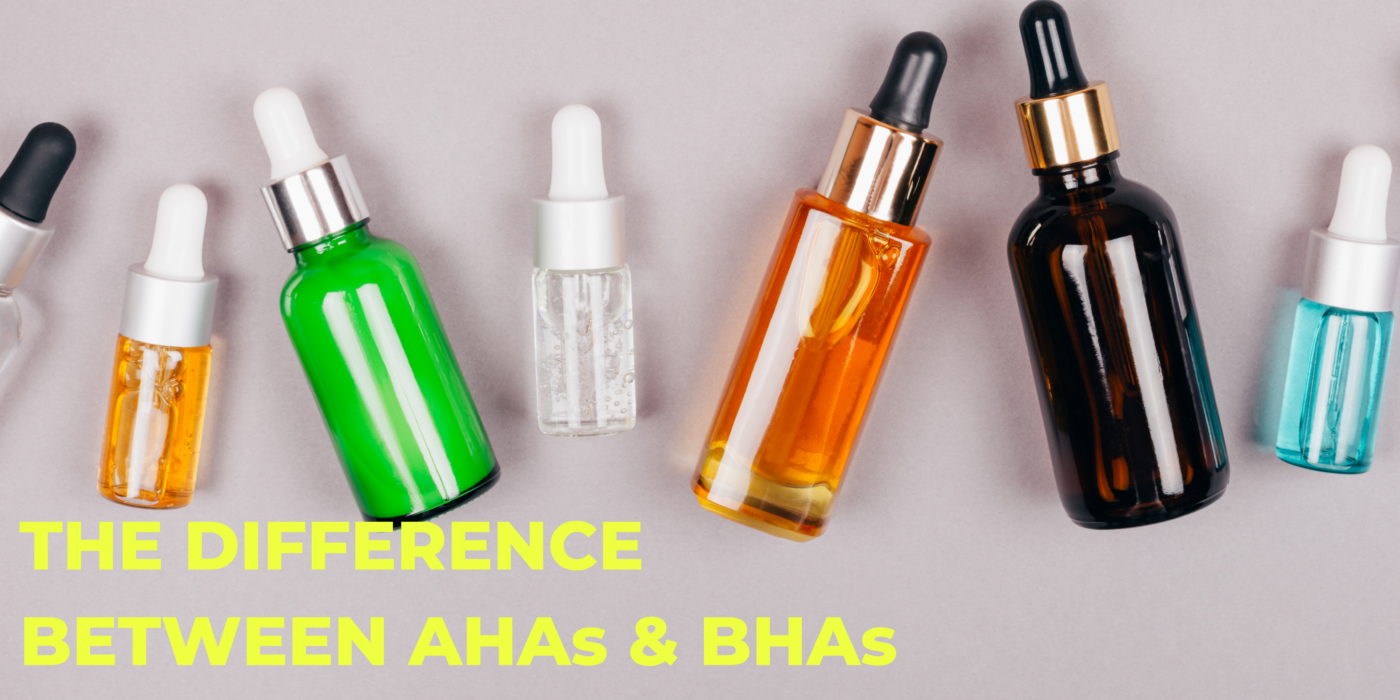What are AHAs and BHAs?
AHAs are alpha hydroxy acids while BHAs stand for beta hydroxy acids. More recently, beta hydroxy acids, or a combination of AHAs and BHAs are being used in skincare products (Nilforoushzadeh & Amirkhani, 2018).
AHAs and BHAs are chemical exfoliants that get rid of dead skin cells. Alpha hydroxy acids are water-soluble which means they mostly act on the surface of the skin. Beta hydroxy acids, on the other hand, are oil-soluble therefore they penetrate the skin through sebaceous glands. Find out more about exfoliation here.
AHAs generally provide more aggressive exfoliation which may be more appropriate to reverse the effects of sun damage and premature ageing. The extent of exfoliation when it comes to AHAs differs with pH, other ingredients in the product, and the type and concentration of the AHA. BHAs on the other hand, tend to be more beneficial in lower concentrations and when at the bottom of your ingredients list (hashtag check your labels). Check for ingredients to avoid when buying skincare products here.
AHAs and BHAs can be found in an array of products including cleansers, toners, serums and even AHA and BHA creams.
Pro tip – Our in-house certified skincare therapist, Joyce Waiharo can help you pick the right exfoliant to use depending on your skin type and skin goals. Book a consultation here.
Benefits of AHAs and BHAs
Cell turnover as a result of using AHAs leads to:
- Reversed premature ageing due to stimulated collagen production
- Reduced pore sizes
- Improved appearance of mild hyperpigmentation
- Improved health and appearance of the skin
- Improved acne
BHAs penetrating deep into the skin to balance oil levels result in improved:
- Acne
- Skin health after sun damage
How to use AHAs and BHAs
AHAs can be used on all skin types. Always pick one with a concentration of 10% or lower, pH of 3.5 and above, and check to see if the product is formulated to protect from increased sensitivity to the sun or directly instructs that you apply sunscreen daily. AHAs have a tendency to increase the sensitivity of the skin to the sun therefore remember to wear sunscreen daily and reapply every 2 to 3 hours – one of our favourite things to do here at Uncover Skincare.
Here are 3 types of AHAs:
- Glycolic acid
Glycolic acid is one of the most popular forms of AHAs. It has antimicrobial properties that improve mild acne and helps to keep the skin moisturised and young when used at a concentration of about 10%. Use a face cream or AHA night cream containing glycolic acid for best results.
- Citric acid
Citric acid evens out rough patches and neutralises the pH levels of the skin. It’s found in many toners and serums and shares similar exfoliating properties with glycolic acid such as improving the skin’s natural moisture.
- Lactic acid
Lactic acid improves the texture and complexion of the skin when old skin cells are removed from its surface. Any brightening AHA cream is likely to contain lactic acid.
One thing we love about BHAs is that they don’t increase the sensitivity of the skin to the sun. However, they shouldn’t be used on infants or children. You can test with a smaller area of the skin before adding it to your skincare routine. Shop our Neulii exfoliating toner pads for sensitive skin containing BHAs here. If you don’t have a skincare routine yet check our beginner’s guide here after taking our skin quiz.
4. Mandelic acid
Mandelic acid is both water and oil soluble and is commonly used as an AHA. Mandelic acid reduces hyperpigmentation on the surface and deeper layers of the skin by inhibiting melanin production. It is non-irritating and perfect for darker skin tones.
The most common BHA:
- Salicylic acid
Salicylic acid is the most common type of BHA. It penetrates the skin and controls excessive amounts of sebum. If you have acne, are looking for mild cleansing, or feel dryness after cleansing shop our AC Clean Saver Cleanser containing salicylic acid here. Use a BHA cream for acne afterward for best results or purchase our entire acne kit here.
PS: Tropic acid and Trethocanic acid are other types of BHAs. Both AHAs and BHAs are designed for daily use so ensure to gradually work your way up when it comes to frequency, especially if you have dry or sensitive skin. In fact, always do this regardless of the product or your skin type to be on the safe side!
How to combine AHAs and BHAs
There are safe ways to combine AHAs and BHAs. Some products come with a mixture of the two and can be used occasionally. You can also alternate between the two types in the morning and evening or on alternate days. If you have combination skin, you could apply AHAs to dry areas and AHBs to oily areas.
AHAs and BHAs should never be layered on top of each other. They do the same job and would therefore irritate the skin unnecessarily. If you experience prolonged stinging or irritation when using either of them, discontinue use immediately.

